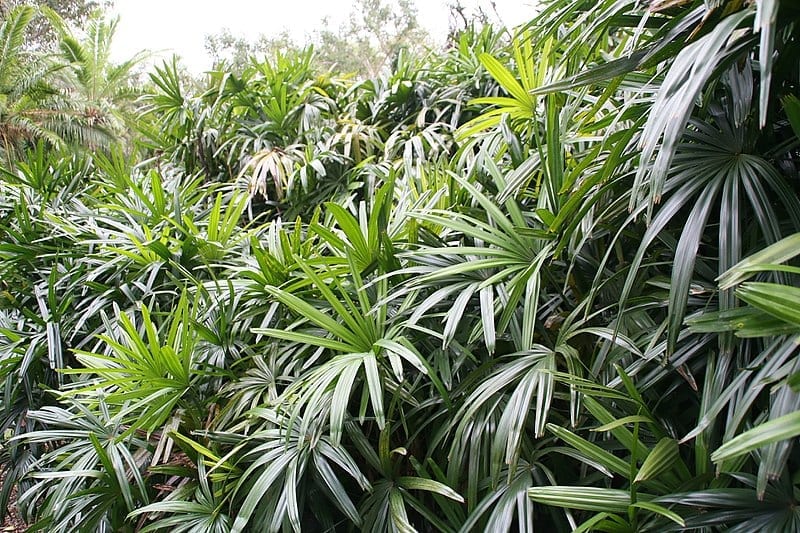
If you like small palm trees, the kind that you can grow in a pot throughout your life either indoors or outdoors, don't hesitate to get one. raphis excelsa. Known as the Chinese palm tree, it is a beautiful, very decorative plant that will not give you problems.
It is very, very easy to care for, since it is quite adaptable. Anyway, so that you have no doubts about it, here is your file,
Origin and characteristics
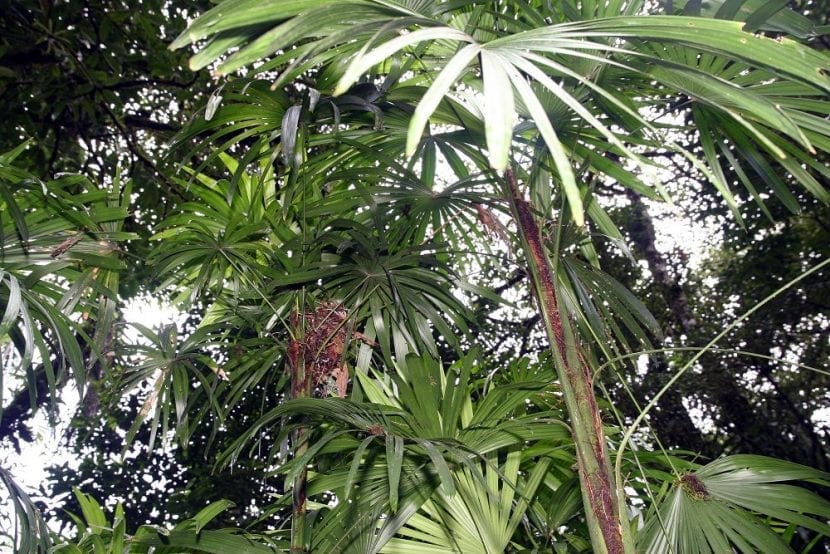
Our protagonist is a multi-stemmed palm tree -of several trunks- native to Asia whose scientific name is raphis excelsaAlthough it is popularly known as the Chinese palm, rapis or bamboo palm. It grows to a height of 3 meters, with stems 4cm in diameter.. Its leaves are webbed and are divided to the base into 3-7 leaflets, sometimes more. These have a finely serrated margin, and are dark green in color. The petiole is very thin and has a length of 30-40cm, with fibrosity at the base.
The flowers are grouped in axillary inflorescences, that is, they arise from the axils of the upper leaves, are up to 30cm long and are yellowish. The fruit is oblong, about 9mm in diameter, and purple-brown.
What are their cares?
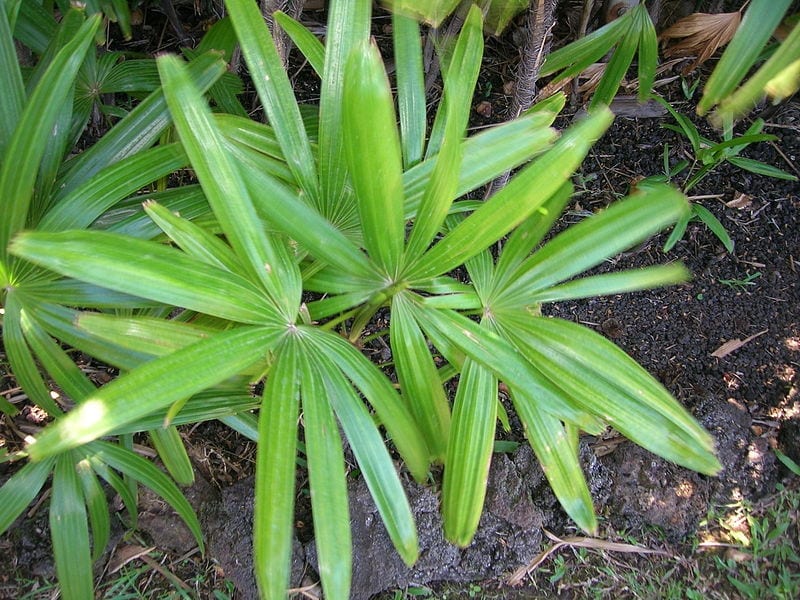
If you want to have a copy, we recommend that you provide it with the following care:
Location
It can be had both inside and outside the home:
- Body exterior:: in semi-shadow.
- Interior: in a bright room.
Earth
La raphis excelsa It is a palm tree that can be both in a pot and in the garden, so the soil will be different:
- Flower pot: I advise mixing 60% of universal growing medium (on sale here) + 30% perlite (you can get it here) + 10% worm castings (get it here).
- Garden: it must have good drainage and be fertile. If it is not, make a 1m x 1m planting hole, and mix the soil with 20% perlite and 15% organic compost such as worm castings.
Irrigation
In general, it resists drought well; so that It should not be watered more than 3 times a week in summer and every 4-5 days the rest of the year. In the case of having it in a pot, I do not recommend putting a plate under it unless it is summer and it is being grown outdoors, since stagnant water will rot the roots.
If in doubt, check the humidity of the soil before proceeding to water the palm tree. To do this you can do any of these things:
- Dig about 5-10cm around the palm tree: if you see that the earth is darker than the surface, do not water.
- Use a digital moisture meter: it can be useful if it is introduced in different areas (closer to the plant, further away).
- Weigh the pot once it has been watered and again after a few days: as soon as you water, the soil weighs more than when it loses moisture, so this difference in weight serves as a guide.
Subscriber
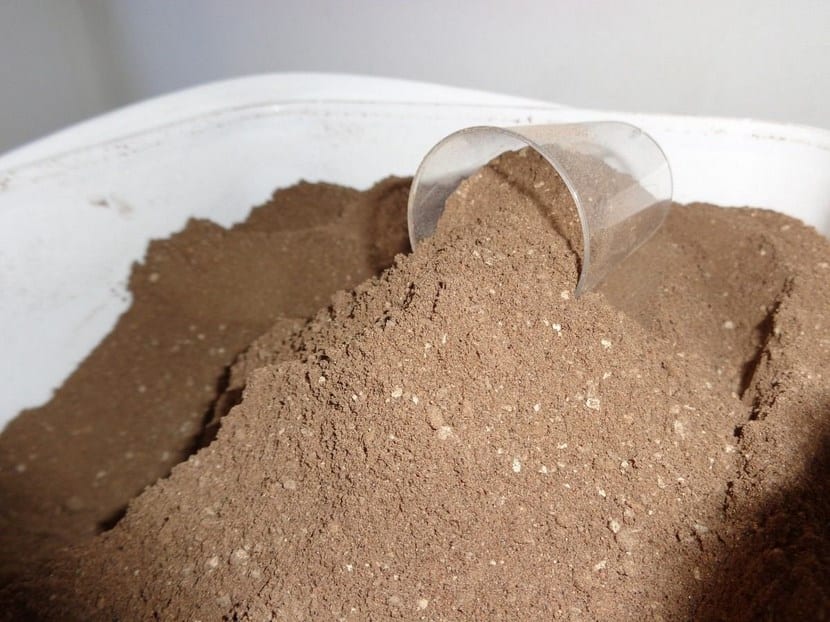
Guano powder.
It is very important to fertilize the Chinese palm throughout the growing season, that is, from spring to summer (it can also be in autumn if you live in an area with a warm or mild climate). For this, the ideal is to use ecological fertilizersand guano which is very rich in nutrients and is very fast effective. You can get it liquid (for pots) here and powdered by here. Of course, follow the instructions specified on the package as it is very concentrated and there is a risk of overdose.
Multiplication
It multiplies by seeds or division in spring. Let's see how to proceed in each case:
Seeds
You have to follow this step by step:
- First you have to fill a pot of about 10,5cm in diameter with universal growing substrate, and water.
- Then, a maximum of 2 seeds are placed on the surface, and covered with a 1cm thick layer with universal growing substrate.
- It is then watered again, this time with a sprayer.
- Finally, the pot is placed outside in semi-shade, or indoors near a heat source.
So will germinate in 1-2 months.
Division
It is usually easy, but you have to bear in mind that it does not always go well. The steps to follow are:
- First, a stem that begins to have a trunk is cut with a saw previously disinfected with pharmacy alcohol.
- Then the base is impregnated with homemade rooting agents or with liquid rooting hormones (you can get them here).
- It is then planted in a pot of about 13cm with vermiculite (for sale here) previously moistened.
- Finally, it is placed in semi-shade or in a bright room (away from direct light).
If everything goes fine will root at 3 weeks more or less.
Plagues and diseases
It's very tough, but if in your area there is the red weevil and / or the paysandisia You must protect your palm tree in spring, summer and even autumn if the weather is warm with the remedies that we tell you. here. In addition, if it is watered in excess it can have fungi, which are treated with fungicides.
Rusticity
Supports up to -2ºC.
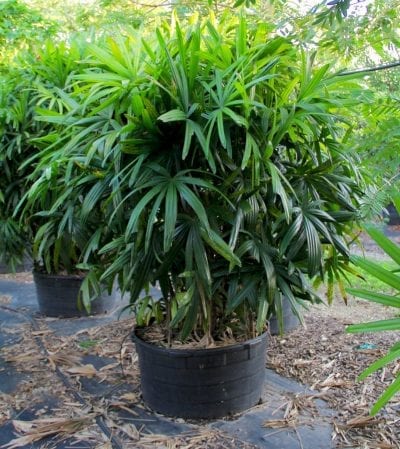
What did you think of raphis excelsa?
Very interesting.
I have a Chinese palm (which I hardly know is one of its names) which they gave me
already in its pot it should measure about 1mt. I just watered it and put in some fertilizer. It has 3 stems but only one of them seems to be alive because it is the one that throws the leaves at me. I do not know and I would like to know more about this palm, because a leaf has just dried 🙁 and it seems that 2 more are going to be there, but it is seen that a new leaf is coming out :), But if I wanted to show it by photography, so that you could give recommendations for their best care, and if possible make the other 2 stems live. I have it indoors, where I live is a warm climate all year round 34 ° c, 20 ° c in autumn winter. It hits natural light through a window, and from 2pm it gets direct sunlight through the window, and at 6pm I open the window to ventilate and shine directly on the sun.
Hello José Aurelio.
I recommend you put it in a place that does not give it direct light, since its leaves will burn.
For the rest, how often do you water it? Do you have a plate under it? In principle, 2-3 irrigations a week during the summer and 1-2 per week the rest of the year will suffice. If you have a plate underneath it, you must remove the excess water after each watering.
If you have questions, contact us.
Greetings.
Hello! I have a Raphis palm about 1.60 meters high, I bought it about 3 weeks ago, but I see that some of its leaves are starting to yellow, the others are fine.
It does not get direct sunlight, but if the light reaches it indirectly, it does not have pests, I water it about 2 times a week approximately, the humidity of the area where I live is approx 37% (according to my app of the weather). I love this palm tree, what could I do to prevent more yellow leaves from turning? Do I apply fertilizer to it? Do I move it to give it more light? I greatly appreciate your comments and time. I am very excited to learn more about caring for my plants.
Hi Lisette.
Is your palm tree in a pot without holes or does it have a plate underneath? If so, I recommend you plant it in one that does have holes in the base, and remove the water from the dish underneath after each watering.
If you are indoors near a window, my advice is to move it a bit away from it to avoid burning.
Greetings.
very good and complete